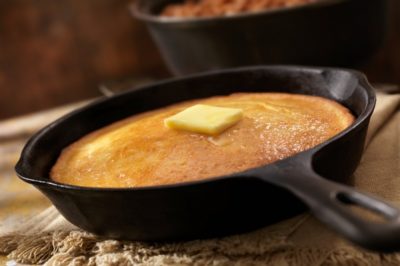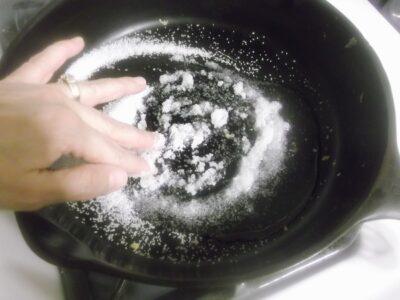
Image source: SheKnows
What would you choose — a rusty cast iron skillet from a garage sale or a shiny new stainless steel or aluminum pan from a kitchen store? Ignoring the cost difference ($100 vs. a few dollars for a used cast iron skillet), there are many reasons I’d choose a cast iron skillet.
First, with some care, cast iron skillets last forever. They evenly heat food and can be used in the oven to finish off a steak or bake cornbread. They can also be used over a campfire or a cook fire. Another benefit is that a cast iron surface gives a nice brown or crusty finish (e.g., on corned beef hash or cornbread) that’s hard to replicate with non-stick cookware. Finally, unlike some high alloy alternatives, you don’t have to worry about toxic fumes that may be released.
So if cast iron is so great, why don’t more people use it? Probably because in this fast-paced, hectic, sleep-deprived society, people simply don’t want to deal with the “s” word. Yes, that’s right, the “s” word, short for “seasoning.”
However, those of us living off the grid are frugal and willing to work a little to derive the benefits that come from doing a job right.
Seasoning and Why It’s Necessary
Without seasoning, food will stick to the cast iron surface. Seasoning refers to a process where fat breaks down into complex carbon chains and forms a hard, smooth fat-resistant surface that rivals the performance of high-end non-stick pans. Seasoning also prevents the cookware from rusting.
How to Season
As with most topics today, you can go on the Internet and get lots of advice about how to season cast iron cookware. The method I provide here works well.
The first step is to prepare the cast iron surface. I’m assuming you bought your cookware from a garage sale or inherited it, but if it’s new then skip this step. Your used cast iron skillet probably has some rust or other unidentified substance on it. Take some steel cloth and gently remove the substance.
Next, gently wash the skillet with warm soap and water. Dry and then place over low heat for a few minutes to make sure all the water is removed.
Are You Ready For The Coming Food Riots?
Turn on the oven to 350 degrees Fahrenheit and let it preheat. Line one of the oven trays with aluminum foil. Meanwhile, rub a thin layer of vegetable shortening all over the skillet, as evenly as possible. Place the skillet upside down on the aluminum foil. This allows any excess shortening to drip onto the aluminum foil.
You can use other oils like vegetable oil or linseed oil, but I’ve had the best luck with vegetable shortening. Lard also works, and some even use olive oil.
Leave the skillet in the oven for four hours, then turn off the oven and let the skillet cool in it overnight. The next morning, take a paper towel and rub off any extra shortening. The skillet should have a nice sheen on it.
Caring for a Seasoned Skillet
There are many great debates these days. Arguments rage between liberals and conservatives, pro-lifers and abortion advocates, and Israelis and Palestinians. But there’s another debate that has raged for decades in modern society: the best way to care for a seasoned cast iron skillet. Although it’s not up there with some of the global disagreements listed above, there are people on both sides of the argument with strong feelings.
Instead of telling you the “right” way to care for your skillet, I’m going to give you three different ways. I’m sure there will be comments excoriating me for my audacity in being reasonable and flexible, but the reality is that there are different ways to care for your seasoned skillet.

Image source: DianesFoodBlog
What’s important is that you do care for it. Over time, especially with skillets recently seasoned for the first time, the seasoned coating will break down and have to be renewed with another seasoning.
So here are three ways to care for a seasoned skillet.
1. Traditional Method
My grandfather’s cast iron skillet has a place of honor in my kitchen. It was one of his few possessions during the Great Depression, and he cared for it his entire life. My grandfather followed the traditional method for cleaning a cast iron skillet after use. After it cooled, he would pour some salt into the pan and gently rub it around the surface with a soft brush. The salt would absorb any remaining food residue (i.e., fat from fried sausage or steak). He would dispose of the salt, and rub the skillet with a towel to ensure all the salt was removed. Then he would rub a thin layer of oil over the pan and put it away. Using this method, my grandfather maintained a seasoned skillet for years. He never washed the pan with soap and water.
2. Modern Method
The traditional method is not for everyone. When I first inherited the skillet, I used the traditional method, but frankly it seemed like a waste of salt and I didn’t feel good about putting greasy salt daily into the garbage, which went into landfills. Others, like chefs in restaurants, have to use water to wash their cookware; otherwise, the health inspector will have an issue.
New “Sun Magic” Solar Oven Is So Fast It’s Been Dubbed “Mother Nature’s Microwave”
With the modern method, use warm water, soap and a sponge to gently clean the cast iron skillet. Dry thoroughly and then rub a coat of oil on the pan. After a month or so of moderate use, you may need to season the cookware again.
3. Non-Traditional, Not Recommended Method
This method is for those who simply can’t be bothered with hand washing a dirty pan and insist on using a dishwasher for everything. (For those cast iron skillet purists out there, please don’t leave hateful comments on this post — I’m just providing information here; you may not like it but some people simply won’t use a cast iron skillet if they have to wash it by hand.)
I tried this method for a month (not on my grandfather’s skillet) and it seemed to work OK.
After use, put the cast iron skillet in the dishwasher. After it has been cleaned and dried, rub a coat of oil on it. You may notice a spot or two of rust. Just rub oil over it and it will be OK (for a short time).
With this method, you can only use the skillet a few times before having to remove the rust and season it again. Again, I don’t recommend this method, but if you insist on using a dishwasher for everything, you can still enjoy the benefits of cast iron.
A cast iron skillet is inexpensive and provides a superior cooking experience. Treat it right and it will last you a lifetime.
How do you season your cast iron skillet? Tell us in the section below:
 Off The Grid News Better Ideas For Off The Grid Living
Off The Grid News Better Ideas For Off The Grid Living




